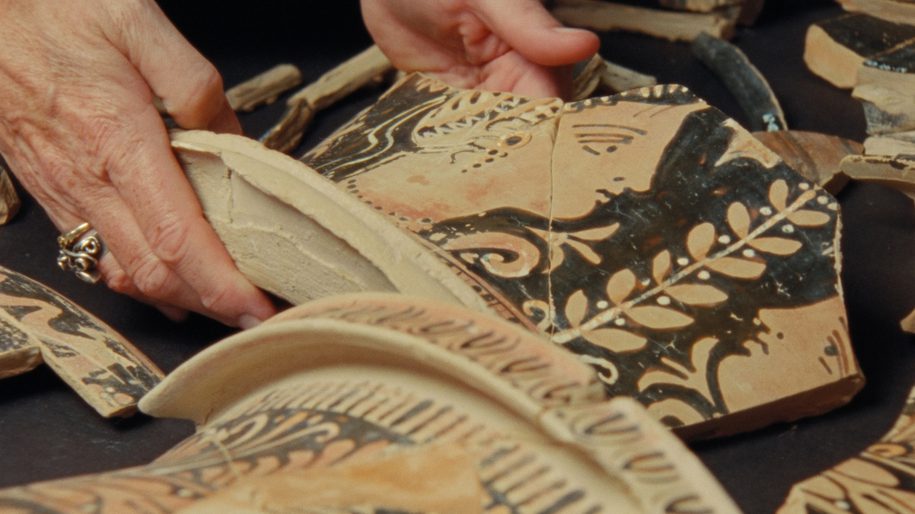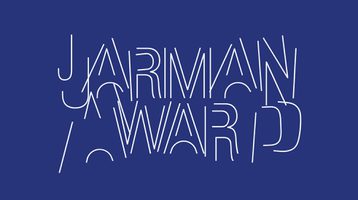Full of missing links: On Maeve Brennan’s An Excavation
The Film London Jarman Award 2024María Palacios Cruz

Maeve Brennan, An Excavation (2022), film still. Commissioned by Stanley Picker Gallery, Kingston University
Maeve Brennan’s An Excavation (2022) begins with text on screen: ‘In 2014, 45 crates of looted antiquities were discovered at Geneva Freeport. Three of the crates, containing 32 cardboard boxes, were sent to archaeologists to search for criminal evidence.’
What follows over the course of the next twenty minutes is the meticulous reconstruction of an ancient vase – ‘object 16’ – pieced back together from fragments that were likely contained across several of the recovered cardboard boxes. The two archaeologists at work, Dr. Christos Tsirogiannis and Dr. Vinnie Norskov, are not only reconstituting an object; they are also piecing together the evidence of a crime – like forensic detectives in a murder scene.
For these are antique objects looted from tombs, illegally trafficked out of Italy to be sold in the largely illicit international antiquities market. In Italy, where all items of archaeological interest belong to the state, the trade in antiquities has been illegal since 1939 – and yet, ‘the halls of the world’s museums and the living rooms of private collectors are cluttered with artifacts looted from Italian soil’.1 Between 1983-1992, 1,236 red-figure vases from Puglia in southern Italy appeared on the international market, and 863 more turned up in private collections; only a small fraction had documented provenance.
Formally, An Excavation is deceptively simple: one object, two characters, one room. But just like an archaeological dig, the film keeps on revealing layers of meaning, excavating through strata of history, art and mythology. The film’s form closely mirrors the archaeologists’ method, starting with the fragment – close-ups of hands and broken pieces – to slowly uncover a larger picture – the space and the archaeologists at work in wide shot – as the pieces of the vase are puzzled back together.
An Excavation is part of a long-term, and ongoing, collaboration between Maeve Brennan and Christos Tsirogiannis, The Goods (2018-present), which also takes the form of billboards that draw from Tsirogiannis’s digital archive of images of more than 100,000 illicitly traded antique objects, in order to draw attention to the largely invisible – and illegal – antiquities market. That these large billboards are presented outside art institutions which are part of the very same art ecosystem that feeds from illegal trafficking is not without irony. Artefacts identified by Tsirogiannis as illegally traded have been found at Frieze Masters, London and the Metropolitan Museum of Art, New York, amongst other places. Art institutions are the primary context where Maeve Brennan’s work is presented, forcing a reflection on the part that the museum plays in a colonial extractive history in which the lines between licit and illicit traffic are blurred.

Maeve Brennan, An Excavation (2022), film still. Commissioned by Stanley Picker Gallery, Kingston University
A forensic archaeologist, Tsirogiannis compares himself to a detective à la Sherlock Holmes, looking for ‘what a criminal must have left behind’, what they missed. Clues are to be found in photographs, inscriptions on boxes, police files – even the newspaper sheets used to wrap the artifacts can provide key information. Polaroids, possibly taken by the looters themselves, are often the only record that exists for looted antiquities. They are unique records and they are also unique prints – with no digital traces, no negatives, no third parties required to develop them and print them. Polaroids are instant and singular – not subject to the mechanical reproduction that is the basis of photography itself. They also underline ‘the clandestine and singular moment of their creation: I was there, and the photograph is the evidence’.2
The task of the archaeologists is to examine, document and note everything, reconstructing the missing links in the trafficking chain. A different kind of ‘excavation’, Tsirogiannis and Norskov have to apply archaeological methods to extract information, to reveal something, perhaps not about the daily lives of ancient peoples but about those of tomb robbers and antiquities dealers. As Vinnie Norskov asks at one point, ‘what if the objects could tell the story?’ Because of the way that the objects were removed, the archaeological context of these artefacts is lost, destroyed by the looters. The work of the archaeologists in An Excavation is to reconstruct it. The aim is reparation, not simply repair.
Brennan’s forensic approach contrasts with the highly romanticised account of the lives of 1980s tombaroli in Alice Rohrwacher’s La Chimera (2023), where the looters are folk heroes whose exploits are celebrated in the songs of local troubadours. But what La Chimera offers us to see is what the forensic archaeologists are attempting to visualise in An Excavation: when and how the artefacts were looted, how, when and where they were laundered, the trafficking chain from tombarolo in Tuscany to collector, with intermediary dealers in Italy and Switzerland. The looted landscapes in La Chimera were the landscapes of Rohrwacher’s childhood and they are also where Brennan’s attention is turning to in the next chapter of The Goods. Over the past two years, she has been travelling in Puglia, tracing the potential looting sites for the items recovered in Geneva in 2014, looking at the ‘buried histories beneath the surface and the illicit excavations that continue into the present day.’3
Tombaroli robbed graves for their financial gain, working hastily and crudely, inflicting devastating damage on archaeological sites which prevents us from accessing significant sources of information about ancient civilisations. Fortunately, frescoes and wall paintings were often left behind but even when the objects are retrieved, or repaired, their histories – and the histories of the people they related to – are lost.
Brennan films the repaired vase in 16mm film and like the looters’ Polaroids, these 16mm images are a testimony to an encounter (‘I was there, and the photograph is evidence’). But these 16mm images are public, intended to be projected in the open space of the museum, not hidden away in a dealer’s archive. At the end, vase number 16 remains incomplete, and so does the story of the looted vases found at Geneva freeport. There are pieces that will always remain missing, full of missing links.
1 Andrew L. Slayman, ‘Italy Fights Back’, Archaeology, vol. 51, no. 3, May / June 1998, pp. 42-49.
2 Vinnie Nørskov, ‘The Use of Photographs in the Trade of Greek Vases’, in Caspar Meyer and Alexia Petsalis-Diomidis (eds.), Drawing the Greek Vase (Oxford University Press, Oxford: 2023), p. 277.
3 ‘Meet the artists: Maeve Brennan’, interview for The British School at Rome, Online (8 June 2023).
María Palacios Cruz is a film curator, writer and educator. She is currently the Director of Open City Documentary Festival in London.



